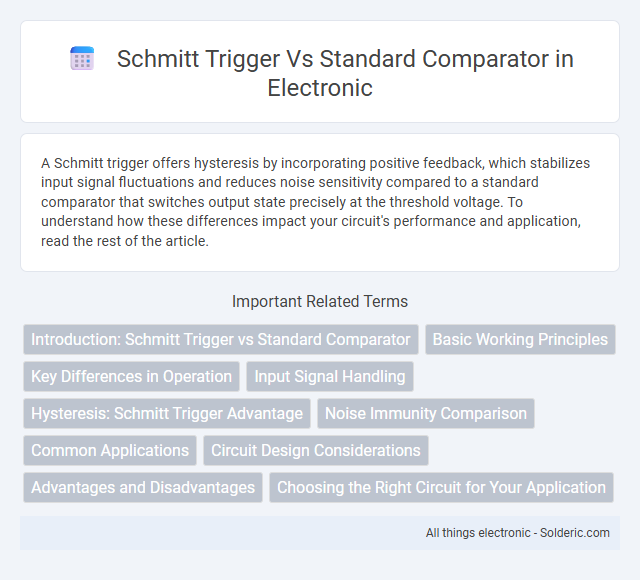A Schmitt trigger offers hysteresis by incorporating positive feedback, which stabilizes input signal fluctuations and reduces noise sensitivity compared to a standard comparator that switches output state precisely at the threshold voltage. To understand how these differences impact your circuit's performance and application, read the rest of the article.
Comparison Table
| Feature | Schmitt Trigger | Standard Comparator |
|---|---|---|
| Function | Converts analog input to digital output with hysteresis | Compares two voltages, outputs high/low based on input difference |
| Hysteresis | Built-in positive feedback provides noise immunity | No hysteresis, sensitive to small input noise |
| Output Stability | Stable switching with less output chatter | Possible output oscillation near threshold |
| Use Case | Signal conditioning, square wave generation, noise filtering | Precise voltage comparison, zero-crossing detection |
| Input Signal | Slow or noisy signals, varying thresholds | Fast, clean input signals preferred |
| Power Consumption | Typically low, depends on implementation | Varies, often similar to Schmitt triggers in IC form |
| Threshold Levels | Two distinct switching thresholds (upper & lower) | Single threshold voltage |
Introduction: Schmitt Trigger vs Standard Comparator
A Schmitt trigger features hysteresis by incorporating distinct threshold voltages for rising and falling signals, enhancing noise immunity and generating a clean digital output from analog inputs. In contrast, a standard comparator switches its output state precisely at a single threshold level without hysteresis, making it more sensitive to noise and signal variations. The hysteresis characteristic of Schmitt triggers is ideal for applications requiring stable switching in noisy environments, whereas comparators are suited for fast, precise voltage level detection.
Basic Working Principles
A Schmitt trigger operates with hysteresis, using positive feedback to create two distinct threshold voltage levels, which stabilizes output switching and reduces noise sensitivity in input signals. In contrast, a standard comparator compares input voltage against a single reference threshold, producing a high or low output without hysteresis, which can cause output oscillations with noisy or slowly changing input signals. The Schmitt trigger's dual-threshold mechanism ensures cleaner transitions, making it ideal for signal conditioning and noise immunity in digital circuits.
Key Differences in Operation
A Schmitt trigger uses hysteresis to provide two distinct threshold voltages for switching, reducing noise sensitivity and preventing output chatter in noisy signals. In contrast, a standard comparator switches output state exactly at a single threshold voltage without hysteresis, making it more susceptible to noise-induced oscillations. This fundamental operational difference allows Schmitt triggers to deliver more stable output in environments with slow or noisy input signal transitions.
Input Signal Handling
A Schmitt trigger features hysteresis, providing distinct upper and lower threshold voltages that prevent output oscillations when input signals fluctuate near the switching point. Standard comparators lack this hysteresis, making them more susceptible to noise and rapid toggling with slowly varying or noisy input signals. Schmitt triggers are ideal for cleaning up noisy or slow-changing signals, ensuring stable and cleaner transitions.
Hysteresis: Schmitt Trigger Advantage
The Schmitt trigger incorporates built-in hysteresis with distinct upper and lower threshold voltages, providing enhanced noise immunity and preventing output oscillations in noisy or slowly varying input signals. Unlike standard comparators, which lack hysteresis and can produce multiple transitions near the threshold voltage, Schmitt triggers ensure clean, stable switching behavior. This hysteresis characteristic makes Schmitt triggers ideal for applications requiring signal conditioning and noise-resistant switching.
Noise Immunity Comparison
A Schmitt trigger offers superior noise immunity compared to a standard comparator due to its built-in hysteresis, which creates distinct threshold voltage levels for switching states. This hysteresis prevents rapid output fluctuations caused by small, noisy input signal variations, making it ideal for applications with noisy or slow-moving signals. Your circuits will benefit from more stable and reliable switching performance, especially in environments where signal integrity is compromised.
Common Applications
Schmitt triggers are commonly used in signal conditioning to convert noisy or analog signals into clean digital outputs, ideal for switch debouncing, waveform shaping, and oscillator circuits. Standard comparators excel in precision voltage comparison for applications such as zero-crossing detectors, ADCs, and level detection in power supplies. Your choice depends on whether you require hysteresis to prevent input chatter (Schmitt trigger) or precise threshold detection (standard comparator).
Circuit Design Considerations
Schmitt triggers incorporate hysteresis by adding positive feedback to the comparator circuit, improving noise immunity and preventing output oscillations in noisy or slow-varying input signals. Standard comparators lack this hysteresis, making them more susceptible to noise and less stable in applications where input signals hover near the threshold voltage. Circuit design with Schmitt triggers often requires careful selection of resistor values to set the upper and lower threshold voltages, optimizing switching behavior for specific signal characteristics.
Advantages and Disadvantages
Schmitt triggers provide hysteresis, reducing noise-induced false switching and improving signal stability in noisy environments, unlike standard comparators which switch output immediately at the threshold voltage. The main advantage of Schmitt triggers is noise immunity and clean digital output transitions, while their disadvantage includes slower response time and increased design complexity compared to standard comparators. Standard comparators offer faster response and simpler design but suffer from noise sensitivity and output instability with slowly varying or noisy input signals.
Choosing the Right Circuit for Your Application
When selecting between a Schmitt trigger and a standard comparator, consider the input signal characteristics and noise immunity requirements. Schmitt triggers offer hysteresis, providing stable switching in noisy or slow-varying signals, making them ideal for signal conditioning and debouncing applications. Standard comparators deliver faster response times and higher accuracy in clean, fast-changing signals, suitable for precise threshold detection but less effective in noisy environments.
Schmitt trigger vs standard comparator Infographic

 solderic.com
solderic.com